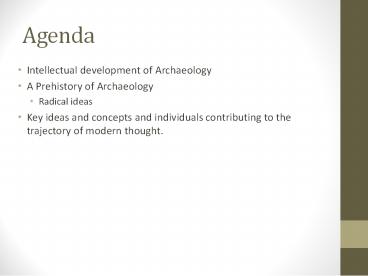Intellectual development of Archaeology - PowerPoint PPT Presentation
1 / 26
Title:
Intellectual development of Archaeology
Description:
Agenda Intellectual development of Archaeology A Prehistory of Archaeology Radical ideas Key ideas and concepts and individuals contributing to the trajectory of ... – PowerPoint PPT presentation
Number of Views:263
Avg rating:3.0/5.0
Title: Intellectual development of Archaeology
1
Agenda
- Intellectual development of Archaeology
- A Prehistory of Archaeology
- Radical ideas
- Key ideas and concepts and individuals
contributing to the trajectory of modern thought.
2
Prehistory of Archaeology
- Paradigms that governed interpretations of
ancient civilizations
3
- Sixteenth century
- Arch Bishop Usher declares earth created on
October 23 in 4004 BC, based on biblical
genealogy at 730 am.
4
Late Eighteenth-century Enlightenment
- Antiquarians are collecting curios and creating
Salons (repositories of interesting objects of
art and artifacts. - Proto-archaeological digs are conducted in search
of more ancient objects. - First scientific observation of previously
unconsidered phenomena. - First systematic attempt to classify ancient
materials.
5
- Antiquarianism efforts at classification
- Interest in antiquities expands following
Napoleon's invasion of Egypt. - Rosetta stone discovered
- Hieroglyphics deciphered (1822) Jean Jacques
Champollion,
6
Important individuals contributing to early
archaeological theory and practice
- James HuttonCharles Lyell develop concept of
uniformitarianism. - Thomas Jeffersonapplication of Principle of
Superposition, systematic excavation (early
1800s) on his property in Virginia.
7
Radical ideas
- Recognition of stratigraphy!
- A changing Earth!
- Recognition that there was a time when humans did
not know of metals!
- Extinction not a static environment!
- Great age of Earth hypothesized!
8
- George Cuvierstudies fossils of extinct animals,
sets out rudimentary theory on evolution. - Thomas JeffersonPrinciple of Association
- Jean Lamarckdetermines Earth much older than
6000 years based on geology and fossils (early
1800s). Suggests 100s of thousands of years.
9
- Charles Lyellexpands on principle of
uniformitarianism (1830s) - Charles DarwinAlfred Wallace establish principle
of natural selection (1859) and conceive of
evolution of species.
10
- Christian ThomsenThree age system
- Jens Worsaechronological validity to three age
systemadds principle of association (1870s)
11
More people
- Heinrich SchliemannFirst systematic excavation
linking historic documents to prehistorystuns
the world with discovery of Troy in 1876. - Accidentally Invents scientific archaeology.
12
- Squire and Davissystematic recording of earthen
mounds in Ohio and Mississippi Valleys. (1870s). - Provide valuable maps and illustrations for
future analysis.
Davis
Squire
13
- Gregor Mendellworks out genetic mechanism for
inheritance of traits (1870s-80s). - If only Darwin had known.
14
- Karl Marxlinks economic basis of societies to
political systemsworks out a theory of society
and capitalism.
15
- Lewis Henry Morganpostulates history in
stageslinks culture stages to technology. Early
proponent of unilinear cultural evolution
(1860s). This theory is now discredited.
16
Unilinear Cultureal development
- Postulates that all cultures pass through
specific phases from savagery to barbarism to
civilization and the stages are bands / tribes/
chiefdoms / states. - Goes further to link a specific list of traits
(including technologies) to these stages which
could be observed archaeologically to rank
societies on a development curve.
17
Impact of theory
- Unilinear Cultural Development theory influenced
interpretation of ancient civilizations and
cultures. It created a technologically informed
hierarchy of cultures (compared to Victorian era
European civilization, which was viewed as a
model for the ultimate development of superior
civilization). - This culture paradigm dominated into the early
20th century and influenced Nazi propaganda and
was combined with NeoDarwinism to foster the idea
of a master race.
18
Using the trait list
- UCD theory allowed anthropologists in the 19th
century to conveniently classify cultures in a
hierarchical scale (naturally with white European
culture at the top). Moreover, lack of culture
complexity came to be equated with evolutionary
primitiveness. - Although obvious problems existed in the system
these were generally explained away.
19
The paradigm shift
- As culture research progressed during the early
20th century many anthropologists questioned the
trait list and addressed the glaring problems. - Multilinear Culture development theory emerged as
a new framework for interpretation.
20
Multilinear Cultural Development
- Postulates that the assumption of stages or
linear development is a false premise and
unproven by evidence. - Culture stage is not directly linked to
technology, economy, or complexity of social
development. - Any society can pass through stages or skip over
so-called stages, even retrograde.
21
Stop
22
MCD
- Postulates that resources and environment
influence culture development and technological
change. - Examples a stone age culture can be a complex
state or a metals based culture may only rise to
level of chiefdom, and so forth.
23
Significance of these theories
- ICD theory fundamentally racist and Eurocentric.
Was used to by colonial empires justify
eradication of uncivilized races. - MCD forced reevaluation of the accomplishments of
ancient cultures and of modern peoples living
under prehistoric conditions.
24
Influence on/of archaeology
- Early researchers sought to classify cultures on
the linear continuum. - But inconsistencies and new data from archaeology
contradicted the dominant paradigm and eventually
forced a change in ideology in the scientific
community.
25
- As we shall see, concepts of civilization,
humanity and evolutionary theory will become
tightly interwoven. This is especially true when
we examine the fate of Neanderthal.
26































